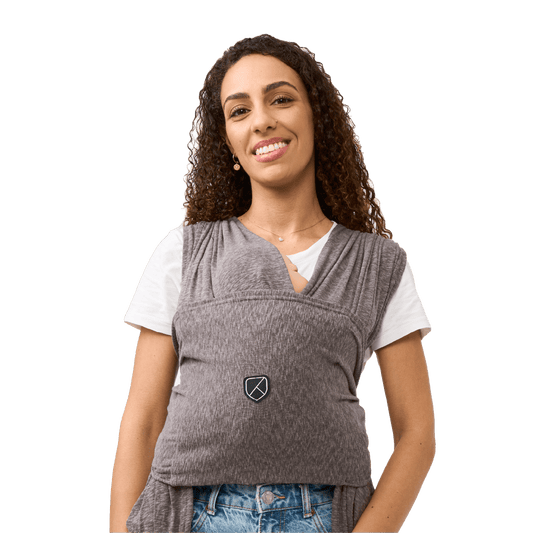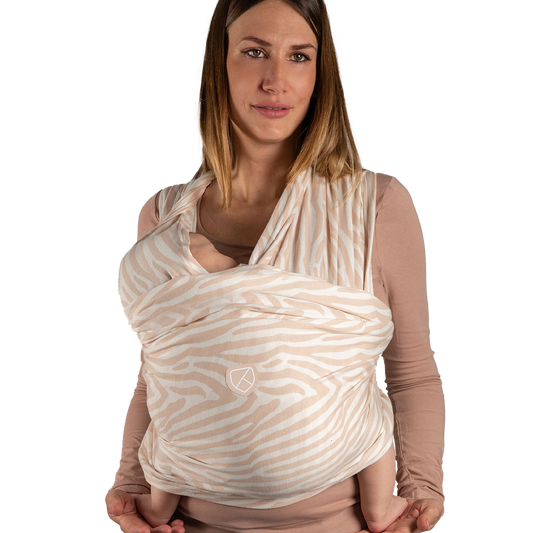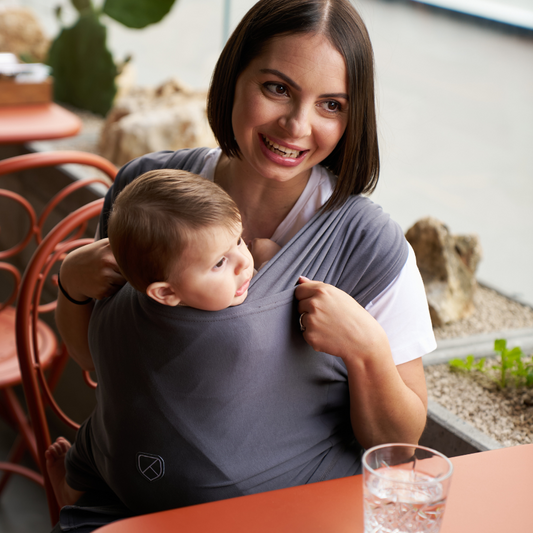What is babywearing? Why is it good for babies and parents alike? Which type of baby carrier to choose? How to use it?
These are just a few of the questions we’ll answer in this comprehensive guide to babywearing. Designed specifically for parents who are new to babywearing.
Let's commence our journey into the world of babywearing newborns. Happy reading!
What is Babywearing?
The term babywearing literally means 'wearing your baby'. Babies are carried in direct contact with their parents' bodies in baby slings (newborn wraps or baby carriers).
Considering babywearing a new trend, couldn’t be any further from the truth: since ancient times mothers worldwide have used slings to carry their babies around.
Ancient populations needed to care for their babies while carrying out activities necessary for survival.
In the modern western world, following the invention of the pram, we’ve lost much of this culture of close contact with our infants, which is an innate basic need of each and every newborn. Today, we are moving back towards this direction, but this is not the only reason why we are returning to babywearing.
Carrying a baby in a baby sling carrier is certainly more comfortable than holding your infant in your arms all the time, and it’s also often much more practical than using a pram. Let's take a look together at what the many benefits of babywearing are.
The many benefits of babywearing for baby and for mum and dad
Babywearing benefits are numerous, not only for a baby’s development but also for the parent’s well-being. Let's take a look at all the benefits of babywearing:
- Infants rediscover the same sensory stimulation they experienced whilst in the womb
- Meets a baby's innate need for physical contact
- Strengthens the emotional bond between parent and baby
- Babies feel safe and protected, which lays the foundation for secure attachment and healthy relationships in the future
- Enables dads to experience those sensations mum felt whilst pregnant and to enhance their own bond with their baby.
- Allows parents to be hands-free to carry out other activities
- Eases colic and reflux in infants
- Calms and soothes babies
Babywearing and Reflux: a natural remedy
Reflux is very common in infants up to 6 months old. The cause is purely physiological: a young infant’s digestive system is still developing. More specifically, the cardia valve, which connects the stomach and oesophagus, does not close properly, causing ingested milk to flow back up.
Babywearing is a valid form of newborn reflux treatment and considered one of the natural remedies for newborn reflux. This is especially true in babies who suffer from more severe cases and, consequently, exhibit common newborn reflux symptoms such as sleep problems, crying more frequently and being generally fussier.
A baby carrier sling keeps baby in an upright (and physiological) position, aiding proper digestion and preventing ingested milk from flowing back up their oesophagus and is, therefore, a great natural remedy in how to ease reflux in newborn babies.
In addition, close heart-to-heart contact with mum or dad also calms and soothes a baby, helping to ease emotional discomfort that colic and reflux can bring.
Which baby carrier to choose?
Navigating through the many different types of baby carriers wraps and slings can prove overwhelming. Let's help clarify which is the best baby carrier for you.
Firstly, it may be helpful if you understand the difference between non-structured and structured infant carriers.
Non-structured baby carriers are pieces of fabric, which are then tied around you in a variety of ways. A stretchy wrap sling or slightly more moulded baby sling wrap both belong to this category.
Mei Tais and ring slings are structured, more rigid baby carriers. These are easier to use as they already have a pre-formed shape. Structured baby carriers, ring slings and Mei Tais all belong to this category.
Stretchy newborn wrap
A stretchy wrap sling is made out of loose fabric, usually cotton or jersey with traces of spandex or elastane to make it stretchy.
This type of material in a stretchy wrap offers the ideal level of softness and support for a newborn baby, wrapping around the baby so snuggly that it reminds newborns of the cosy environment they were used to when inside mummy’s tum.
This type of infant sling is usually suitable for babies weighing up to 10-15 kilos.
👉 Discover Koala Cuddle Wrap Stretchy for newborns!
Structured baby carriers
A structured baby carrier sling can be made of cotton, hemp or other non-stretchy material. This allows it to be more versatile, as it can be adjusted to support the weight of a child up to 2-3 years old.
Ring slings
A ring sling carrier has two aluminium rings positioned at one end of the fabric.
It’s particularly suited to hip-carrying, although it’s not suitable for prolonged use in this position as weight is loaded onto one shoulder.
It is not recommended until an infant reaches 3 months old as it doesn’t allow for an infant to be held close up tight to their parent's body.
What about a baby carrier?
It’s a babywearing carrier with shoulder straps, back support and straps and is therefore easier to use as it doesn’t need tying.
It’s recommended for use with infants from 4 months old as it’s less tight-fitting than a baby wrap.
Pre-tied baby carrier sling
This is an infant carrier which is already pre-tied, meaning it’s much easier to use and quicker to put on.
There are a variety of different pre-tied baby carriers available, some have a ring system, while others come with pre-moulded straps that you put on like a backpack. Koala Cuddle Band and Koala Cuddle Band 2 both belong to this category: they slip on like a t-shirt and all that remains to do is to tuck your baby inside, and then finish of tying it with just a few simple steps.
It’s ideal for those who are new to babywearing, and for those who are looking for an ergonomic, yet swift and practical, baby carrier!
How to wrap a baby sling – pre-tied Koala Cuddle Band 2
Koala Cuddle Band 2 can be tied in two ways:
- Simple X is the tying method that’s used the most
- Double Hammock is ideal for newborn babies
Watch the videos and discover how to tie a baby wrap following the instructions baby wrap carrier!
Which is best: baby wrap or baby carrier?
We are led to believe that we either have to choose between an infant wrap or an infant carrier, as if one excludes the other.
In reality, this is not the case at all.
Stretchy wrap slings are the most suitable type of newborn baby carriers during the first months of a baby’s life, so much so that they are also ideal for premature infants. It wraps around and supports baby in the best possible way to meet a newborn baby’s needs, more so than a structured baby carrier, which is a lot more rigid.
As a baby grows, they naturally want to move around more, and a baby carrier sling, which allows a baby to move their legs, arms and head freely, becomes more comfortable.
When can I start babywearing and when to stop babywearing?
Babywearing is suitable from birth, when using an ergonomic infant sling carrier that respects a newborn’s physiology, i.e. the natural C-curve of their spine, and also favours correct development of their hips.
You can use a baby sling, wrap or carrier up to when your child reaches 5 or 6 years old, but age and weight limit vary from baby carrier to baby carrier.
Generally speaking, stretchy newborn wraps are suitable for babies up to about 10 kg (Koala Cuddle Band 2 and Koala Cuddle Wrap, on the other hand, are tested up to 15 kg).
Structured baby carriers are generally suitable up to 20 kg.
👉 Learn more by reading Baby Slings, wraps and carriers: when can I start using one from and what’s the maximum baby weight?
How to wrap a baby sling? Here’s how!
A stretchy baby wrap is perfect for those who like to experiment with different babywearing positions, as it can be used for a variety of carrying positions and, therefore, accompanies a baby as they grow and begin exploring the world around them.
Let’s commence with the heart-to-heart newborn babywearing position, perfect for newborns, and then move on to hip and back baby sling positions.
Let's take a look at the tutorials of a few of the different tying methods:
Triple Support
This is a very practical and quick way to tie your infant wrap and can be left in without having to untie it completely, so you can slip it on in just a few steps whenever needed.
Double Hammock
This tying method is perfect for supporting newborn babies as it respects their physiology and makes them feel just as safe and snug as when they were in the womb.
Sling hip carrying
Hip carrying with a stretchy wrap is ideal for when your baby has learnt to hold up their little head and has started to explore the world with curiosity.
Using babywearing to help your baby fall asleep: why it’s a great help.
If your baby struggles to settle down to a nap or suffers from sleep disorders, a baby sling can be one of the best ways to get a newborn to sleep.
Babywearing can magically calm a fussy, over stimulated and over tired newborn and settle them into a peaceful sleep.
Using a baby wrap carrier to facilitate your baby’s sleep can help you too, especially if newborn who will only sleep when held or when they’re physically close to you, as by babywearing you’re free to move around as you like.
Having your baby sleep in their infant sling when out and about is also ideal for isolating them from an over-stimulating environment, such as noise or light.
All that’s left is to wish you happy babywearing!










